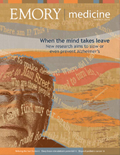Not quite out of the woods
Physicians need to pay close attention to the heart health of pediatric cancer survivors
By Dana Goldman
Emory endocrinologist Lillian Meacham knows that there usually comes a time when children bald from chemotherapy will begin to regrow their hair. Eventually a family who’s grown accustomed to waiting rooms can go back to work and school. They can focus, again, on life.
Meacham 84M 88MR has seen this scenario play out many times over since mortality rates for pediatric cancer have plummeted in recent decades. Now 80% of pediatric cancer patients are cured.
That rising cure rate is not the whole story though, says Meacham, an Emory pediatrics professor and medical director of the Cancer Survivor Program at Aflac Cancer Center of Children’s Healthcare of Atlanta. In recent years, she and other researchers in the relatively new field of cancer survivorship have been looking at what happens to pediatric cancer survivors in the years after the completion of cancer therapy, in the decades after life goes back to normal.
“I’ve always said that our goal in cancer survivor work is to make these people as normal and healthy as possible and to improve their quality of life,” Meacham says. “In survivorship we try to be sure they can be as healthy as possible either by preventing long-term consequences or detecting them early and intervening.”
Now Meacham and her colleagues have completed another round of detection work with large implications for childhood cancer survivors. What they found in work published in the January issue of Cancer Epidemiology, Biomarkers & Prevention was that these survivors have significantly increased risk for heart disease.
“Risk factors are manifesting in adults in their early 30s, which is much earlier than a non-cancer survivor would exhibit signs of cardiovascular risk factors,” says Meacham.
Meacham directed the research study from her office, decorated with pictures of her own daughters, now young adults, and with a flock of the stuffed ducks now synonymous with the Aflac name. Her report uses data from the Childhood Cancer Survivor Study, a decades-long project following thousands of former pediatric cancer patients, many of whom are now in their 40s and 50s. Fellow paper author and Emory oncology epidemiologist Ann Mertens ran that study during its first phase. For this paper, Mertens and Meacham collaborated to compare 8,599 survivors’ adult health with the health of a group of almost 3,000 of their cancer-free siblings.
“We found that survivors were more likely to have high blood pressure, elevated lipids, and diabetes,” Meacham says. The risk wasn’t just incremental in nature. “They were 90% more likely to have high blood pressure and to be on a medication for hypertension, 60% more likely to be on medication for elevated lipids, and 70% more likely to have diabetes. Together, these three conditions and obesity make up metabolic syndrome and increase an individual’s risk of heart disease.”
In all, that cluster of risk factors has made cancer survivors as a group highly susceptible to heart attacks and strokes—and at such young ages that many doctors don’t screen patients for those health issues.
The findings also show that not all cancer treatments are created equal when it comes to long-term effects on cardiovascular health. While chemotherapy doesn’t appear to directly increase risk of metabolic syndrome, exposure to radiation showed a particularly potent link to diabetes, hypertension, and high cholesterol. Says Meacham, “If survivors had been exposed to total body irradiation or irradiation to the chest or abdomen, they were much more likely to have these risk factors.” Total body irradiation was linked with a 5.5-fold increased risk, while radiation directed toward the chest and abdomen led to a 2.2-fold increased risk.
Researchers including Meacham still don’t know why radiation in children is associated with greater cardiovascular risk as they age. Meacham speculates that radiation affects body organs in ways not yet understood—and is hopeful that future studies will clarify that impact. If doctors can understand radiation’s long-term impact on a molecular level, they may be able to minimize the risk while enhancing the benefits of radiation treatments.
In the midst of these sobering findings, Meacham did see one piece of good news: Obesity, another major risk factor for heart disease, wasn’t any more prevalent among pediatric cancer survivors than among their siblings. In both groups, just more than 1 in 5 participants were obese.
Now, as further research continues, Meacham is spreading the word that physicians need to pay close attention to the heart health of pediatric cancer survivors. And she hopes these latest findings trickle down to national guidelines for treating adult cancer survivors. “In survivors, we need to start screening and be active much earlier,” she says. EM



